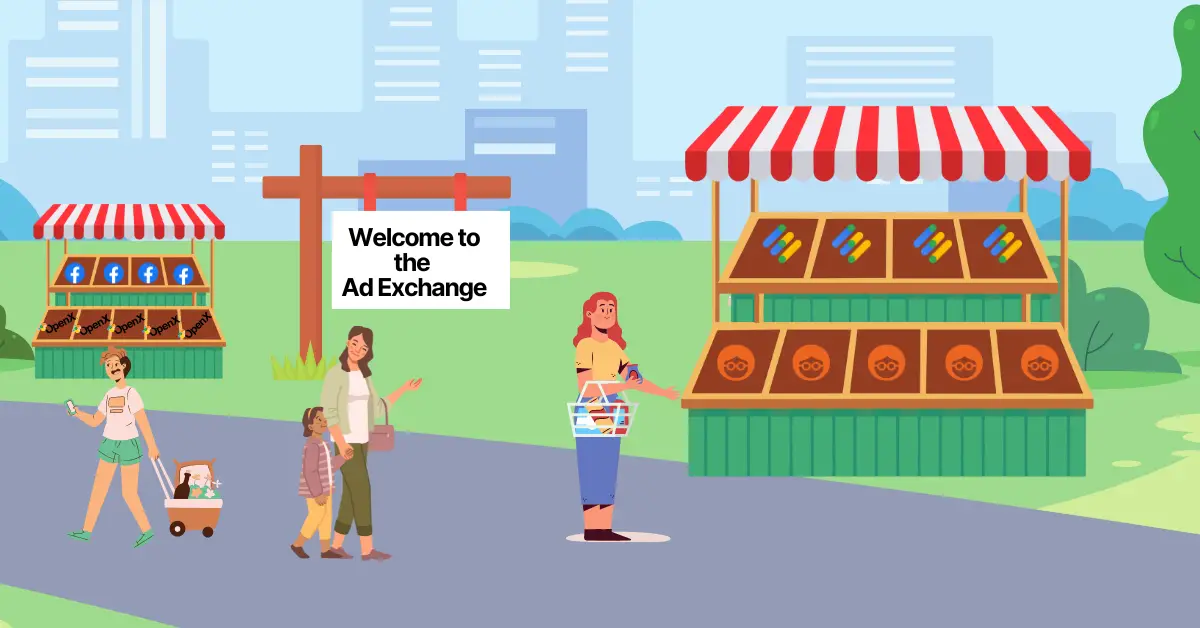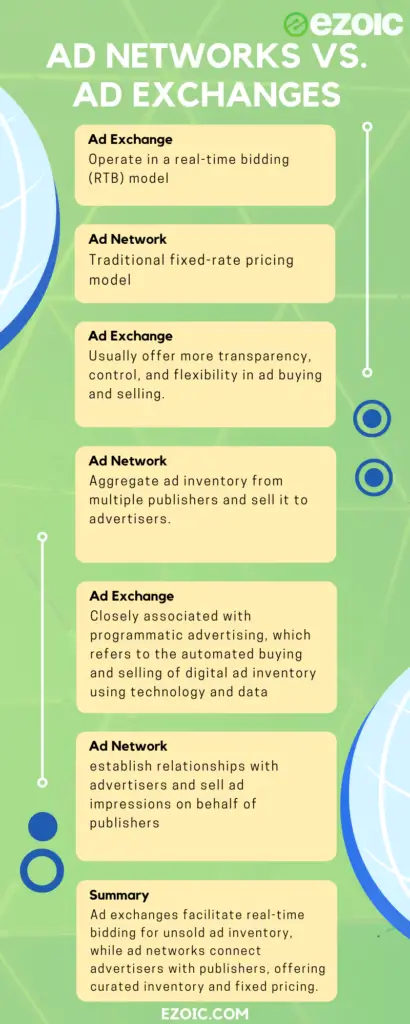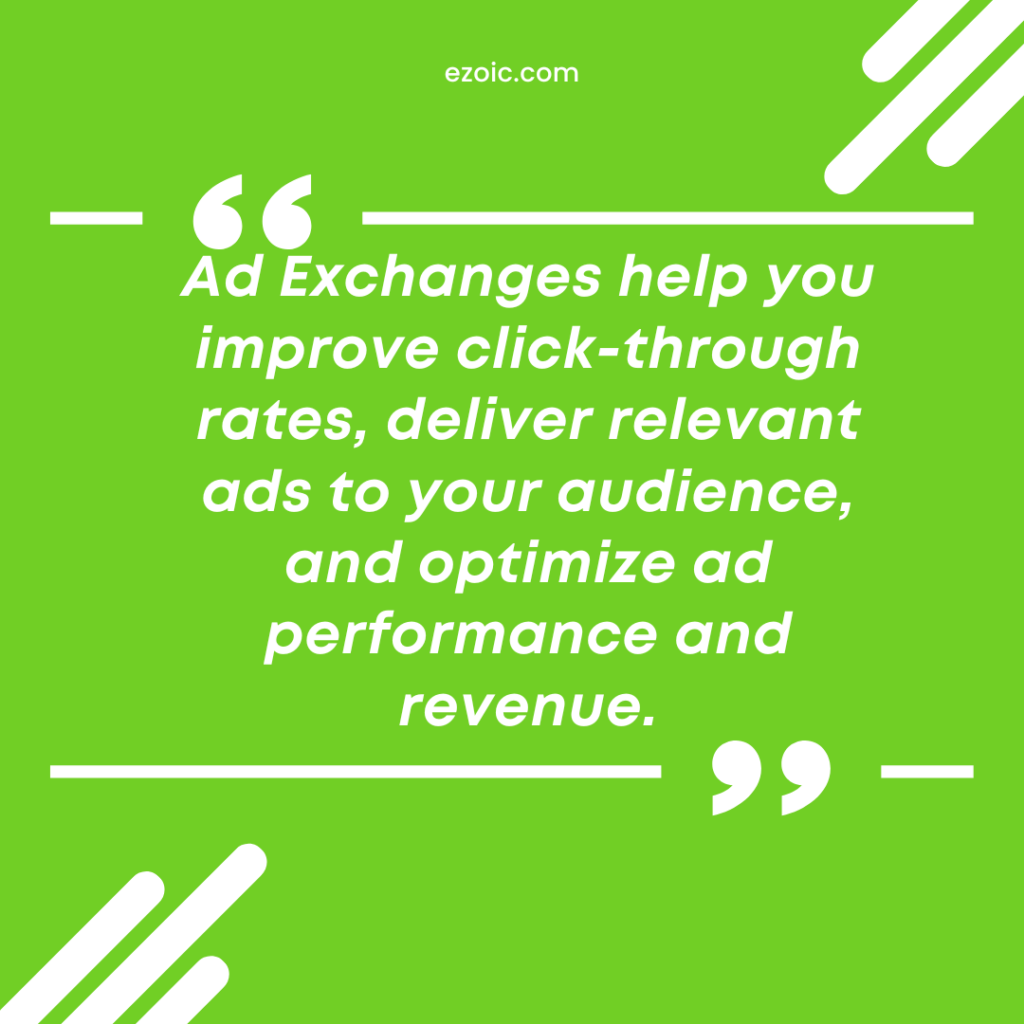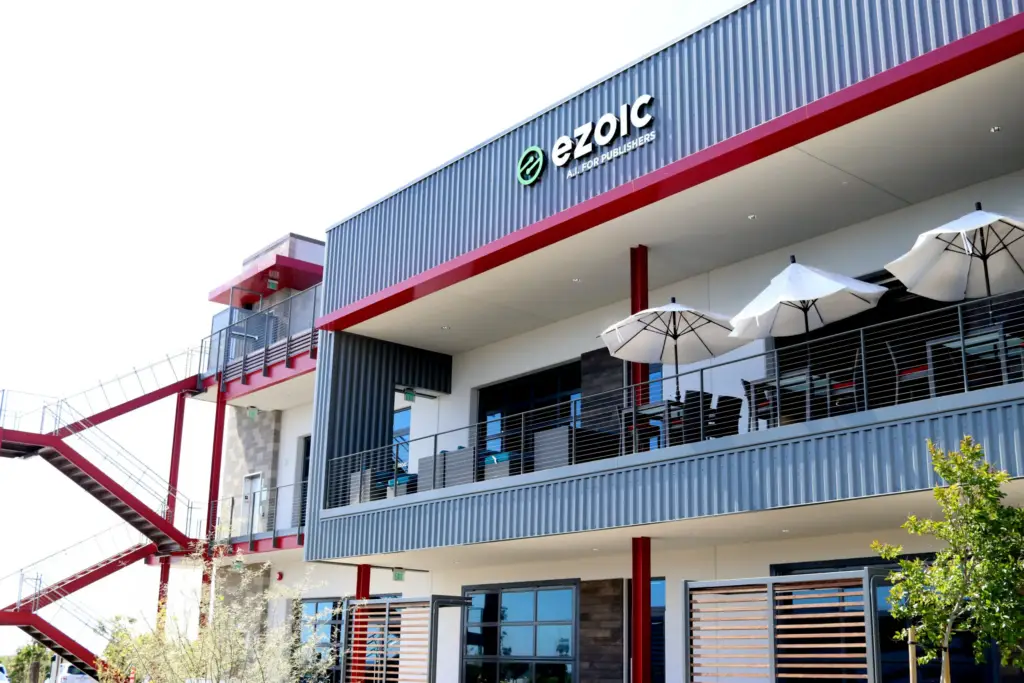
Increase Your Website’s Ad Revenue with Ad Exchanges: A Step-by-Step Guide

Get helpful updates in your inbox
The truth is, a lot of publishers can follow the same traditional marketing strategies that have worked for decades for ad revenue — keyword optimization, writing good content, fast site speed, content marketing, etc. After a year or two of hard work, site owners can probably realistically expect to make around $1,000/month, give or take. It’s a decent return, sure. But it’s not a fortune.
Then, there are other sites. You know the ones I’m talking about — sites that make thousands of dollars, tens of thousands of dollars, or over a hundred thousand dollars a month in revenue.
Those sites are different. Those site owners are different. They routinely do different things and practice different strategies than the vast majority of publishers.
One of those strategies is understanding ad exchanges.
To maximize your site’s revenue potential, it is crucial to understand the role of ad exchanges in the digital advertising ecosystem. This article serves as a comprehensive guide for website owners, shedding light on the definition, purpose, and immense potential of ad exchanges in driving ad revenue. If you can understand ad exchanges and how they work, you can significantly increase your site’s earning potential.
What is an Ad Exchange?
At its core, an ad exchange is a digital marketplace that facilitates the buying and selling of ad inventory through programmatic advertising. Acting as intermediaries, ad exchanges bring together publishers who have ad space available and advertisers looking to reach their target audience.
The primary purpose of ad exchanges is to create an environment where advertisers can bid on and purchase ad inventory in real time. This real-time bidding (RTB) process enables advertisers to optimize their campaigns, ensuring that their ads are served to the right audience at the right moment. Ad exchanges play a crucial role in the digital advertising ecosystem by providing several key benefits to website owners:
First, increased revenue. Ad exchanges open up a world of opportunities for website owners to generate higher ad revenue, the primary goal for most publishers. By connecting with a vast network of advertisers, website owners can attract bids for their ad inventory, leading to increased competition and potentially higher revenue streams.
Next, targeted advertising. Ad exchanges offer sophisticated targeting options that allow advertisers to reach their desired audience with precision, helping you maximize each visitor’s ad revenue potential. This targeted approach enhances the relevance and effectiveness of ad campaigns, leading to higher engagement and better performance.
Ad exchanges also offer real-time optimization. Advertisers can adjust their bids and targeting parameters in response to campaign performance, ensuring that their ads are reaching the most responsive audience segments.
Many site owners are concerned with what types of ads their audience sees, and which ad types typically result in higher revenue. Ad exchanges support various ad formats, including display ads, native ads, video ads, and more. This flexibility allows website owners to experiment with different formats and find the ones that resonate best with their audience, ultimately driving higher engagement and ad revenue.
Obviously, there’s a lot of nuance and depth that ad exchanges offer site owners, but the conclusion is clear: ad exchanges can significantly increase a site’s earning potential. Publishers would do well to learn how ad exchanges work, and how they can best position their site to earn the most revenue possible.
Understanding the power and potential of ad exchanges empowers website owners to make informed decisions, implement effective strategies, and capitalize on the dynamic nature of programmatic advertising. By leveraging the capabilities of ad exchanges, website owners can unlock new revenue streams, drive targeted ad campaigns, and stay ahead in an ever-competitive digital marketplace.
What’s the Difference Between an Ad Exchange and Ad Network?
While ad exchanges and ad networks share similarities, it’s essential to differentiate between them to make informed decisions for ad revenue optimization. Here are some key distinctions:
- Ad Exchanges vs. Ad Networks: Ad exchanges operate on a real-time bidding (RTB) model, whereas ad networks typically work on a traditional fixed-rate pricing model. Ad exchanges offer more transparency, control, and flexibility in ad buying and selling. Ad networks often aggregate ad inventory from multiple publishers and sell it to advertisers.
- Ad Exchanges vs. Other Advertising Platforms: Ad exchanges differ from other advertising platforms such as demand-side platforms (DSPs) and supply-side platforms (SSPs). DSPs primarily focus on advertisers, helping them manage and optimize their ad campaigns across multiple ad exchanges and inventory sources. SSPs, on the other hand, primarily cater to publishers, allowing them to manage and monetize their ad inventory across various ad exchanges.

Understanding the difference between an ad network and an ad exchange is crucial for website owners looking to maximize their ad revenue. While both serve as intermediaries between advertisers and publishers, the distinctions between them can significantly impact your revenue optimization strategies.
An ad exchange operates on a real-time bidding (RTB) model, where advertisers bid in real-time for ad impressions on your website. This dynamic system introduces transparency, control, and flexibility, enabling you to maximize the value of your ad inventory. Ad exchanges provide detailed reporting on ad performance, audience demographics, and key metrics, empowering you to fine-tune your ad strategy for better results. By participating in real-time bidding, you increase the chances of earning higher revenue from your ad space.
On the other hand, ad networks typically operate on a fixed-rate pricing model and aggregate ad inventory from multiple publishers to sell it to advertisers. While they offer convenience by streamlining the ad buying and selling process, they may not provide the same level of transparency and control as ad exchanges. Ad networks can be beneficial for reaching a wider range of advertisers, but they may not offer the same revenue optimization opportunities as real-time bidding on ad exchanges.
It’s also important to distinguish ad exchanges from other advertising platforms such as demand-side platforms (DSPs) and supply-side platforms (SSPs). DSPs focus on helping advertisers manage and optimize their ad campaigns across multiple ad exchanges and inventory sources. SSPs, on the other hand, cater to publishers, allowing them to manage and monetize their ad inventory across various ad exchanges. Understanding these distinctions helps you identify the right platforms and strategies to effectively reach your target audience and maximize your ad revenue.
By knowing the difference between an ad network and an ad exchange, as well as other advertising platforms, you can make informed decisions that align with your revenue optimization goals. Incorporating ad exchanges into your ad strategy can provide increased transparency, control, and flexibility, leading to higher revenue potential. It’s essential to evaluate the available options and leverage the right platforms to ensure you are capitalizing on the full potential of your ad inventory and reaching your revenue goals.
How Do Ad Exchanges Work?
Ad exchanges are digital platforms that act as intermediaries, facilitating the buying and selling of ad inventory in real time through programmatic advertising. Their primary purpose is to seamlessly connect advertisers and publishers, helping both achieve their financial goals.
Ad exchanges create a marketplace where publishers and site owners can offer their available ad space, while advertisers can bid on and purchase this inventory in real time. The ultimate goal is to match the right ad with the right audience at the right moment, maximizing the effectiveness of digital advertising campaigns (something Ezoic does automatically for your site).
Ad exchanges operate within the broader digital advertising ecosystem, leveraging technology to automate and streamline the ad buying process. Here’s a step-by-step breakdown of how ad exchanges work:
Step 1: Inventory Availability
Website owners or publishers make their ad inventory available through the ad exchange, specifying details such as ad formats, placements, and targeting options.
Step 2: Bid Requests
Ad exchanges send bid requests to potential advertisers, providing information about the available ad impressions. These bid requests typically include details such as the ad placement, the target audience, and the available inventory’s attributes.
Step 3: Advertiser Bids
Advertisers evaluate the bid requests and submit their bids based on the relevance and value they perceive for their target audience. The bids can be automated through real-time bidding (RTB) platforms, enabling advertisers to make instantaneous bids for specific ad impressions.
Step 4: Ad Auction
The ad exchange facilitates an auction where advertisers compete against each other in real time. The highest bidder wins the right to display their ad in the publisher’s inventory.
Step 5: Ad Delivery
Once the auction is complete, the winning advertiser’s ad is delivered to the publisher’s website, targeting the intended audience and maximizing the ad’s impact.
This entire process happens instantly, which is why using advanced AI tools like Ezoic is so much more lucrative than manually doing everything yourself (you’re just one human with two eyes and ten fingers; AI models can process thousands of critical points instantaneously and make optimal revenue decisions faster than you can blink!).
While larger media groups can have access to ad exchanges, publishers can only gain access to an ad exchange by going through a reseller like Ezoic. These large media groups are only able to do so through having dedicated staff members to manage inventory, optimizations, relationships with demand partners, etc.
In the past, back when publishers lacked the convenience of utilizing an ad server like Ad Manager that could facilitate real-time bidding auctions, they had to manually integrate various ad networks and ad tags onto their websites, resulting in a time-consuming and complex process for each individual publisher. Programmatic advertising and personal relationships between publishers and advertisers was crucial, and neither really gained much valuable data from this approach.
Once ad exchanges became more prominent and complex, publishers recognized the impact of metrics such as ad demand, indicating the number of ad networks running, on their ad revenue. Since becoming widely used, ad exchanges have revolutionized digital advertising through real-time bidding (RTB), offering transparency, control, expansive reach, data-driven optimization, and a seamless user experience.
Why Ad Exchanges Are the Key to More Revenue
Through ad exchanges that facilitate real-time bidding (RBT), website owners can participate in a thriving market projected to reach $46 billion by 2023. With real-time bidding, advertisers have the opportunity to bid in real-time for ad impressions on your website. This dynamic system significantly increases the chances of earning higher revenue from your valuable ad space.
One of the major advantages of ad exchanges is the transparency and control they offer to publishers. By participating in ad exchanges (through partnering with a tool like Ezoic), you gain access to detailed reporting on ad performance, audience demographics, and key metrics. These valuable insights enable you to fine-tune your ad strategy and optimize your revenue streams. Publishers who leverage ad exchanges have reported a 32% increase in revenue, thanks to improved targeting and optimization based on data-driven insights.
Ad exchanges provide website owners with the opportunity to connect with a wide range of advertisers. By accessing a vast pool of ad inventory from various publishers, ad exchanges offer scalability and reach that can attract higher bids and increased competition for your ad space. Programmatic advertising, which utilizes ad exchanges, is projected to account for 86.2% of all digital display ad spending in the United States in 2021, highlighting the immense potential for reaching your target audience effectively.
The key to maximizing your ad revenue lies in data-driven optimization. Ad exchanges leverage sophisticated algorithms and user data to deliver highly targeted ads. By analyzing user demographics, browsing behavior, and historical performance, ad exchanges ensure that the ads displayed on your website are relevant and engaging. This personalization increases the likelihood of user engagement, click-throughs, and conversions, ultimately driving higher revenue for you as a publisher.
Ad exchanges offer dynamic ad serving capabilities that enhance the user experience on your website. By utilizing real-time bidding and serving ads tailored to the user’s profile and page context, ad exchanges deliver ads that seamlessly integrate with your website’s content. This approach reduces ad blindness and increases the chances of user interaction with the ads, further boosting your revenue potential.
Understanding the power of ad exchanges is essential for website owners aiming to increase their ad revenue. By participating in real-time bidding, leveraging data-driven insights, and embracing dynamic ad serving, you can unlock new opportunities to maximize your revenue potential. Embrace the transparency, scalability, and data-driven optimization of ad exchanges to supercharge your website’s ad revenue and deliver a seamless user experience.
Maximizing Ad Revenue with Ad Exchanges
You never want to leave money on the table; sadly, many publishers do each month! Creating revenue streams (like ad revenue) is one part of being a successful publisher, but maximizing those revenue streams is a different skill entirely. Let’s talk about how to maximize your ad revenue through ad exchanges.
First, having above-the-fold placeholders is crucial, as many advertisers consider this to be one of, if not the most sought-after placeholder on a site. Positioning your ads above the fold ensures they are immediately visible to users when they land on your website. This prime placement increases the chances of capturing their attention and driving higher click-through rates.
Next, contextual targeting: Aligning your ads with relevant content creates a seamless user experience and increases the likelihood of engagement. By understanding the context in which your ads are displayed, you can enhance their effectiveness and encourage users to click on them. Then you can experiment with different ad sizes and formats to find the ones that resonate best with your audience. Test various options such as banners, interstitials, or native ads to determine which formats generate higher click-through rates.
Utilize demographic information such as age, gender, and interests to deliver personalized ads to specific audience segments. Tailoring your ads based on user demographics increases their relevance and boosts engagement.
This can also be applied to geographic targeting, segmenting your audience based on their location to serve ads that are geographically relevant. By targeting users in specific regions, you can ensure your ads resonate with their local interests and preferences. The same goes for behavioral targeting, leveraging user behavior data to target individuals who have exhibited specific actions or interests. This approach allows you to deliver ads that align with their browsing history, preferences, and past interactions, increasing the likelihood of conversions.
You’ll also have a wealth of data to use to make more informed revenue decisions. Regularly monitor key metrics such as click-through rates (CTR), conversion rates, and revenue per thousand impressions (RPM) to gauge the effectiveness of your ad campaigns. Identify underperforming ads and make data-driven adjustments to optimize performance, like A/B testing; conduct A/B tests to compare different ad variations, targeting options, or placement strategies. By experimenting with different elements, you can identify the most effective combinations that drive higher click-through rates and revenue.
This can help with conversion tracking to measure the impact of your ads on user actions, such as sign-ups, purchases, or form submissions. Analyzing conversion data helps you understand which ads are driving the most valuable outcomes and adjust your strategy accordingly.
Remember — Ezoic does all this for you in the most optimal way possible, saving you countless hours of doing all the work on your own, or even hiring full-time staff to manage it for you.

Maximizing ad revenue with ad exchanges requires a strategic approach that incorporates ad placement optimization, targeted segmentation, and data-driven decision-making. By implementing these strategies, you can improve click-through rates, deliver relevant ads to your audience, and optimize ad performance and revenue. Stay proactive in monitoring and analyzing data to refine your approach continuously. Embrace the power of ad exchanges and unlock the full potential of your ad revenue today.
Additional Revenue Generation Opportunities
There are always ways you can maximize, optimize, and tweak your current strategies to bring in more revenue, especially with the surging popularity and accessibility of AI tools to assist you. Website owners have the opportunity to explore additional revenue generation avenues beyond traditional ad exchanges. By diversifying revenue streams and leveraging emerging advertising models, publishers can unlock new opportunities for increased ad revenue.
Programmatic advertising has gained significant traction in recent years, revolutionizing the way ads are bought and sold. It offers advanced targeting capabilities, allowing publishers to deliver highly relevant ads to their audience. By leveraging granular targeting options based on demographics, interests, and browsing behavior, publishers can increase engagement and generate higher revenue. It typically requires a more personal relationship between you and an advertiser, making deals and contracts based on specific data and potential from your site.
In addition, programmatic platforms often provide access to premium advertisers and premium ad inventory. This exposure to high-quality ads and premium brands can lead to higher bids and increased revenue potential for publishers.
You can also integrate revenue streams through native advertising and sponsored content. These forms of advertising blend in with the website’s content, making them less intrusive and more appealing to users. Here’s how publishers can leverage native advertising and sponsored content:
Native Advertising: Native ads match the form and function of the website or platform on which they appear, providing a non-disruptive and cohesive experience. Publishers can monetize their website by incorporating native ads that align with their content, attracting higher engagement and generating additional revenue.
Sponsored Content: Sponsored content involves partnering with brands to create informative or entertaining content that aligns with the publisher’s niche or audience. This collaboration provides an opportunity for publishers to generate revenue while delivering valuable content to their readers. Publishers should ensure transparency by clearly labeling sponsored content to maintain trust with their audience.
Next, you can focus on partnerships and collaborations to expand your opportunities for direct ad deals. Establishing partnerships and collaborations with advertisers and agencies can unlock new revenue streams and opportunities for website owners. By forging direct relationships with brands, publishers can negotiate custom ad deals, sponsorships, or branded content campaigns. Here’s how publishers can explore partnerships:
Direct Ad Sales / PMP’s: Reach out to brands directly to explore opportunities for direct ad sales. Tailor your offerings to align with their marketing goals and target audience. Customized ad packages or sponsorships can provide higher revenue potential compared to standard programmatic ads (you’ll probably have the best chance to do this by presenting relevant and contextual data from your site that proves your site is a good place for them to advertise). Private Marketplace (PMP) deals are direct ad sales via an ad exchange and enable programmatic buyers to reserve (guarantee) ads from certain sites in exchange for paying a premium.
Affiliate Marketing: Partnering with brands through affiliate marketing programs can be a lucrative revenue stream. By promoting products or services through affiliate links on your website, you earn a commission for each conversion or sale generated through your referrals.
Collaborations with Agencies: Collaborating with advertising agencies can open doors to exclusive campaigns and collaborations. Agencies can connect publishers with relevant brands and negotiate mutually beneficial deals that optimize ad revenue.
In short, programmatic advertising provides efficient targeting and access to premium demand, while native advertising and sponsored content offer seamless integration and engagement. Additionally, partnerships and collaborations with advertisers and agencies enable publishers to unlock direct ad deals and custom opportunities. By diversifying revenue streams and exploring these strategies, website owners can boost their ad revenue and create a sustainable business model in the dynamic world of digital advertising.
In Conclusion
Understanding and leveraging the power of ad exchanges can be a game-changer for website owners looking to maximize their ad revenue.
By participating in real-time bidding and tapping into a vast network of advertisers, website owners can attract higher bids, increase competition, and unlock new revenue streams. Ad exchanges offer sophisticated targeting options, real-time optimization, and flexibility in ad formats, allowing website owners to reach their desired audience with precision and drive higher engagement.
The transparency, control, and data-driven insights provided by ad exchanges empower publishers to make informed decisions and optimize their ad strategy for better results. With the projected growth of programmatic advertising, embracing ad exchanges becomes even more crucial for staying ahead in the competitive digital marketplace.
By incorporating ad exchanges into their revenue optimization strategies, website owners can unlock new ad opportunities, deliver a seamless user experience, and supercharge their ad revenue.
FOOTNOTE from Ezoic CCO – John Cole:
Thanks for reading this article. I wanted to add a footnote here about the importance of how A.I. systems are interacting with advertiser budgeting strategies inside Ad Exchanges like ADX, A9 and Microsoft Advertising / Xandr. Advertisers have, for a long time, used sophisticated bidding algorithms to help them improve ad yield over time. These bidding systems reveal an asymmetric data advantage enjoyed by advertisers. Ad companies can identify the groups / types of individuals they want to target and publishers have no idea what those users are worth. Quite often, publishers using ad exchange systems offer their inventory for sale and do not have the corresponding technical sophistication to counter these buying strategies. They are wrong-footed by these A.I. bidding systems and have their best users ‘skimmed off the top’, missing out on the up-side from those high value users, that is rightfully theirs.
The best way to predict the value of any impression and set it correctly is to set the bid floor for that impression on a per-impression basis. This would be impossible to do without A.I. and – if possible – a server side connection (where the system can act as a proxy and deliver the page and the ads, gathering data on both as well as the effect of ads on UX). The presence of other ads on the same page or within the same user session, or the connection speed, or the upstream traffic source or the zip code of the user – all affect the price of each ad. At Ezoic – we’ve had the slogan ‘A.I. for Publishers” next to our logo for the last 10 years.

We have found that the more data we give a machine learning system to accurately predict and set bid floors – on a per-impression basis – the more money the system can generate for the publisher. Actually removing ads from a page can improve overall earnings and push prices up; which is why the system adapts the ad configuration for each user.
Changing ad sizes, ad densities by viewport for example, is incredibly difficult to do, but is essential if you want to improve user experience metrics as well as overall session revenue/EPMV. Using A.I. and ad exchange data together, Ezoic’s system helps publishers get the most out of all ad exchanges.

Anthony Moore is a writer, speaker, and coach. He's helped hundreds of entrepreneurs create successful businesses, and has gained over 7 million views for his work on entrepreneurship, personal growth, and productivity.
Featured Content
Checkout this popular and trending content

Ranking In Universal Search Results: Video Is The Secret
See how Flickify can become the ultimate SEO hack for sites missing out on rankings because of a lack of video.
Announcement

Ezoic Edge: The Fastest Way To Load Pages. Period.
Ezoic announces an industry-first edge content delivery network for websites and creators; bringing the fastest pages on the web to Ezoic publishers.
Launch

Ezoic Unveils New Enterprise Program: Empowering Creators to Scale and Succeed
Ezoic recently announced a higher level designed for publishers that have reached that ultimate stage of growth. See what it means for Ezoic users.
Announcement
